From inside (document excerpt):
kia, the company Congratulations! Your selection of a KIA was a wise investment. It will give you years of driving pleasure. Now that you are the owner of a KIA vehicle, you’ll probably be asked a lot of questions about your vehicle and the company like “What is a KIA? “, “Who is KIA? “, “What does `KIA’ mean? “. Here are some answers. First, KIA is the oldest car company in Korea. It is a company that has thousands of employees focused on building high-quality vehicles at affordable prices. The first syllable, KI, in the word “KIA ” means “to arise from to the world ” or “to come up out of to the world “.
User and Operator’s Vehicle Manual Guide. Free Auto PDF Manual Download. Years covered by this manual: 2008.
The second syllable, a, means “Asia “. So, the word KIA, means “to arise from ” or “to come up out of Asia to the world “. Drive safely and enjoy your Kia! Foreword Thank you for choosing a KIA vehicle. When you require service, remember that your dealer knows your vehicle best. Your dealer has factory-trained technicians, recommended special tools, genuine KIA replacement parts and is dedicated to your complete satisfaction. Because subsequent owners require this important information as well, this publication should remain with the vehicle if it is sold. This manual will familiarize you with operational, maintenance and safety information about your new vehicle. It is supplemented by a Warranty and Consumer Information manual that provides important information on all warranties regarding your vehicle. We urge you to read these publications carefully and follow the recommendations to help assure enjoyable and safe operation of your new vehicle. KIA offers a great variety of options, components and features for its various models. Therefore, some of the equipment described in this manual, along with the various illustrations, may not be applicable to your particular vehicle. The information and specifications provided in this manual were accurate at the time of printing. KIA reserves the right to discontinue or change specifications or design at any time without notice and without incurring any obligation. If you have questions, always check with your KIA dealer. We assure you of our continuing interest in your motoring pleasure and satisfaction in your KIA vehicle. 2007 Kia Motors Corp. i Introduction Your vehicle at a glance Safety features of your vehicle Features of your vehicle table of contents Driving your vehicle What to do in an emergency Maintenance Specifications & Consumer information Index 1 2 3 4 5 6 7 8 I ii Introduction How to use this manual / 1-2 Fuel requirements / 1-3 Vehicle break-in process / 1-4 Indicator symbols on the instrument cluster / 1-5 1 Introduction HOW TO USE THIS MANUAL A010000AUN We want to help you get the greatest possible driving pleasure from your vehicle. Your Owner’s Manual can assist you in many ways. We strongly recommend that you read the entire manual. In order to minimize the chance of death or injury, you must read the WARNING and CAUTION sections in the manual. Illustrations complement the words in this manual to best explain how to enjoy your vehicle. By reading your manual, you learn about features, important safety information, and driving tips under various road conditions. The general layout of the manual is provided in the Table of Contents. A good place to start is the index; it has an alphabetical listing of all information in your manual. Sections: This manual has nine sections plus an index. Each section begins with a brief list of contents so you can tell at a glance if that section has the information you want. You will find various WARNINGs, CAUTIONs, and NOTICEs in this manual. These WARNINGs were prepared to enhance your personal safety.You should carefully read and follow ALL procedures and recommendations provided in these WARNINGs, CAUTIONs and NOTICEs. WARNING A WARNING indicates a situation in which harm, serious bodily injury or death could result if the warning is ignored. CAUTION A CAUTION indicates a situation in which damage to your vehicle could result if the caution is ignored. A NOTICE indicates interesting or helpful information is being provided. NOTICE 1 2 Introduction FUEL REQUIREMENTS A020101AUN-EU A020103AUN-EU Your new vehicle is designed to use only unleaded fuel having a pump octane number ((R+M)/2) of 87 or highter. Your new vehicle is designed to obtain maximum performance with UNLEADED FUEL, as well as minimize exhaust emissions and spark plug fouling. CAUTION Never add any fuel system cleaning agents to the fuel tank other than what has been specified. (Consult an authorized KIA dealer for details.) WARNING · Do not “top off ” after the nozzle automatically shuts off when refueling. · Tighten the cap until it clicks, otherwise the Check Engine light will illuminate. · Always check that the fuel cap is installed securely to prevent fuel spillage in the event of an accident. Gasoline containing alcohol and methanol Gasohol, a mixture of gasoline and ethanol (also known as grain alcohol), and gasoline or gasohol containing methanol (also known as wood alcohol) are being marketed along with or instead of unleaded gasoline. Do not use gasohol containing more than 10% ethanol, and do not use gasoline or gasohol containing any methanol. Either of these fuels may cause drivability problems and damage to the fuel system. Discontinue using gasohol of any kind if drivability problems occur. Vehicle damage or drivability problems may not be covered by the manufacturer’s warranty if they result from the use of: 1. Gasohol containing more than 10% ethanol. 2. Gasoline or gasohol containing methanol. 3. Leaded fuel or leaded gasohol. “E85 ” fuel is an alternative fuel comprised of 85 percent ethanol and 15 percent gasoline, and is manufactured exclusively for use in Flexible Fuel Vehicles. “E85 ” is not compatible with your vehicle. Use of “E85 ” may result in poor engine performance and damage to your vehicle’s engine and fuel system. KIA recommends that customers do not use fuel with an ethanol content exceeding 10 percent. CAUTION Your New Vehicle Limited Warranty does not cover damage to the fuel system or any performance problems caused by the use of “E85 ” fuel. CAUTION Never use gasohol which contains methanol. Discontinue use of any gasohol product which impairs drivability. 1 3 Introduction VEHICLE BREAK-IN PROCESS A020104AUN A020105AUN A030000AUN Use of MTBE KIA recommends avoiding fuels containing MTBE (Methyl Tertiary Butyl Ether) over 15.0% vol. (Oxygen Content 2.7% weight) in your vehicle. Fuel containing MTBE over 15.0% vol. (Oxygen Content 2.7% weight) may reduce vehicle performance and produce vapor lock or hard starting. Do not use methanol Fuels containing methanol (wood alcohol) should not be used in your vehicle. This type of fuel can reduce vehicle performance and damage components of the fuel system. A020106AUN CAUTION Your New Vehicle Limited Warranty may not cover damage to the fuel system and any performance problems that are caused by the use of fuels containing methanol or fuels containing MTBE (Methyl Tertiary Butyl Ether) over 15.0% vol. (Oxygen Content 2.7% weight.) Gasolines for cleaner air To help contribute to cleaner air, KIA recommends that you use gasolines treated with detergent additives, which help prevent deposit formation in the engine. These gasolines will help the engine run cleaner and enhance performance of the Emission Control System. A020107AUN Operation in foreign countries If you are going to drive your vehicle in another country, be sure to: · Observe all regulations regarding registration and insurance. · Determine that acceptable fuel is available. No special break-in period is needed. By following a few simple precautions for the first 1,000 km (600 miles) you may add to the performance, economy and life of your vehicle. · Do not race the engine. · While driving, keep your engine speed (rpm, or revolutions per minute) between 2,000 rpm and 4,000 rpm. · Do not maintain a single speed for long periods of time, either fast or slow. Varying engine speed is needed to properly break-in the engine. · Avoid hard stops, except in emergencies, to allow the brakes to seat properly. · Don’t let the engine idle longer than 3 minutes at one time. · Don’t tow a trailer during the first 2,000 km (1,200 miles) of operation. 1 4 Introduction INDICATOR SYMBOLS ON THE INSTRUMENT CLUSTER A050000AUN-EC Door ajar warning light Seat belt warning light High beam indicator Turn signal indicator Front fog light indicator (if equipped) ESC indicator (if equipped) ESC OFF indicator (if equipped) ABS warning light (if equipped) Parking brake & Brake fluid warning light Engine oil pressure warning light Low windshield washer fluid level warning light (if equipped) Charging system warning light Malfunction indicator Air bag warning light Cruise indicator (if equipped) Cruise SET indicator (if equipped) Immobilizer indicator (if equipped) Tailgate open warning light Low fuel level warning light * For more detailed explanations, refer to “Instrument cluster ” in section 4. 1 5 Your vehicle at a glance Interior overview / 2-2 Instrument panel overview / 2-3 Engine compartment / 2-4 2 Your vehicle at a glance INTERIOR OVERVIEW 1. Door lock/unlock button .4-11 2. Inner door handle 4-12 3. Outside rearview mirror control switch 4-32 4. Central door lock switch 4-12 5. Power window lock button .4-19 6. Power window switches 4-17 7. Fuse box 7-45 8. Instrument panel illumination control knob 4-35 9. ESC OFF button* 5-19 10. Front windshield deicer button* 4-60 11. Hood release lever 4-20 12. Steering wheel 4-29 13. Steering wheel tilt lever .4-30 14. Seat .3-2 * : if equipped OUN008001N B010000AUN-EU 2 2 Your vehicle at a glance INSTRUMENT PANEL OVERVIEW 1. Driver’s front air bag .3-48 2. Light control / Turn signals .4-52 3. Instrument cluster .4-34 4. Wiper/Washer .4-55 5. Auto cruise controls* .5-24 6. Ignition switch .5-4 7. Vent controls 4-64/4-73 8. Digital clock 4-87 9. Hazard warning flasher switch .4-51/6-2 10. Audio controls* 4-92 11. Climate control system* 4-61/4-70 12. Shift lever .5-7 13. Seat warmer* .3-7 14. Shopping bag holder* 4-88 15. Passenger’s front air bag .3-48 16. Glove box .4-80 17. Parking brake pedal .5-15 18. Brake pedal 5-14 19. Accelerator pedal .5-6 * : if equipped OUN007002N B020000AUN 2 3 Your vehicle at a glance ENGINE COMPARTMENT 2.4L Engine 1. Engine coolant reservoir .7-17 2. Engine oil filler cap .7-16 3. Brake fluid reservoir 7-20 4. Air cleaner .7-25 5. Fuse box .7-46 6. Negative battery terminal .6-4/7-28 7. Positive battery terminal .6-4/7-28 8. Automatic transaxle fluid dipstick 7-22 9. Radiator cap .6-6/7-19 10. Engine oil dipstick .7-16 11. Power steering fluid reservoir .7-21 12. Windshield washer fluid reservoir .7-24 * The actual engine room in the vehicle may differ from the illustration. OUN078001L B030000AUN-EU 2 4 Your vehicle at a glance 2.7L Engine 1. Engine coolant reservoir .7-17 2. Engine oil filler cap .7-16 3. Brake fluid reservoir 7-20 4. Air cleaner .7-25 5. Fuse box .7-46 6. Negative battery terminal .6-4/7-28 7. Positive battery terminal .6-4/7-28 8. Automatic transaxle fluid dipstick 7-22 9. Radiator cap .6-6/7-19 10. Engine oil dipstick .7-16 11. Power steering fluid reservoir .7-21 12. Windshield washer fluid reservoir .7-24 * The actual engine room in the vehicle may differ from the illustration. OUN078001 2 5 Seats / 3-2 Seat belts / 3-18 Child restraint system / 3-32 Air bag-advanced supplemental restraint system / 3-40 Safety features of your vehicle 3 Safety features of your vehicle SEATS Front seat (1) Forward and backward (2) Seatback angle (3) Seat cushion height (Driver’s seat)* (4) Seat warmer* (5) Headrest Power seat 2nd row seats (6) Forward and backward* (7) Seatback angle (8) Walk-in seat* (9) Headrest Manual seat 7-Seater 3rd row seats* (10) Folding the seatback (11) Headrest *: if equipped 5-Seater 7-Seater OUN027059L C010000AUN-EE 3 2 Safety features of your vehicle WARNING – Loose objects Loose objects in the driver’s foot area could interfere with the operation of the foot pedals, possibly causing an accident. Do not place anything under the front seats. WARNING – Driver responsibility for passengers Riding in a vehicle with seatback reclined could lead to serious or fatal injury in an accident. If a seat is reclined during an accident, the occupant’s hips may slide under the lap portion of the seat belt applying great force to the unprotected abdomen. Serious or fatal internal injuries could result. The driver must advise the passenger to keep the seatback in an upright position whenever the vehicle is in motion. WARNING – Driver’s seat · Never attempt to adjust seat while the vehicle is moving. This could result in loss of control, and an accident causing death, serious injury, or property damage. · Do not allow anything to interfere with the normal position of the seatback. Storing items against a seatback or in any other way interfering with proper locking of a seatback could result in serious or fatal injury in a sudden stop or collision. · Always drive and ride with your seatback upright and the lap portion of the seat belt snug and low across the hips. This is the best position to protect you in case of an accident. · In order to avoid unnecessary and perhaps severe air bag injuries, always sit as far back as possible from the steering wheel while maintaining comfortable control of the vehicle. We recommend that your chest be at least 10 inches (250 mm) away from the steering wheel. WARNING – Uprighting seat When you return the seatback to its upright position, hold the seatback and return it slowly and be sure there are no other occupants around the seat. If the seatback is returned without being held and controlled, the back of the seat could spring forward resulting in accidental injury to a person struck by the seatback. 3 3 Safety features of your vehicle WARNING – Rear seatbacks (2nd and/or 3rd row) · The rear seatback must be securely latched. If not, passengers and objects could be thrown forward resulting in serious injury or death in the event of a sudden stop or collision. · Luggage and other cargo should be laid flat in the cargo area. If objects are large, heavy, or must be piled, they must be secured. Under no circumstances should cargo be piled higher than the seatbacks. Failure to follow these warnings could result in serious injury or death in the event of a sudden stop, collision or rollover. · No passenger should ride in the cargo area or sit or lie on folded seatbacks while the vehicle is moving. All passengers must be in seats and restrained properly while riding. (Continued) (Continued) · When resetting the rear seatback to the upright position, make sure it is securely latched by pushing it forward and backwards. · To avoid the possibility of burns, do not remove the carpet in the cargo area. Emission controls beneath this floor generate high exhaust temperatures. OUN028033 Front seat adjustment – manual WARNING After adjusting the seat, always check that it is securely locked into place by attempting to move the seat forward or reverse without using the lock release lever. Sudden or unexpected movement of the driver’s seat could cause you to lose control of the vehicle resulting in an accident. C010101AUN Forward and backward To move the seat forward or backward: 1. Pull the seat slide adjustment lever under the front edge of the seat cushion up and hold it. 2. Slide the seat to the position you desire. 3. Release the lever and make sure the seat is locked in place. Adjust the seat before driving, and make sure the seat is locked securely by trying to move forward and backward without using the lever. If the seat moves, it is not locked properly. 3 4 Safety features of your vehicle C010104AUN Headrest The headrest not only provides comfort for the driver and front passenger, but also helps to protect the head and neck in the event of a collision. WARNING · For maximum effectiveness in case of an accident, the headrest should be adjusted so the middle of the headrest is at the same height as the top of the occupant’s eyes. Also adjust the headrest so its distance from the head is as wide as your fist. For this reason, the use of a cushion that holds the body away from the seatback is not recommended. · Do not operate the vehicle with the headrests removed as severe injury to the occupants may occur in the event of an accident. Headrests may provide protection against neck injuries when properly adjusted. · Do not adjust the headrest height while the vehicle is in motion. OUN028035 C010102AUN C010103AUN OUN028034 Seatback angle To recline the seatback: 1. Lean forward slightly and lift up on the seatback recline lever located on the outside of the seat at the rear. 2. Carefully lean back on the seat and adjust the seatback of the seat to the position you desire. 3. Release the lever and make sure the seatback is locked in place. (The lever MUST return to its original position for the seatback to lock.) Seat cushion height (for driver’s seat) To change the height of the seat cushion, push the lever that is located on the outside of the seat cushion upwa …..
job; just dampening the accumulated mud rather than washing it away will accelerate corrosion rather than prevent it. Water under high pressure and steam are particularly effective in removing accumulated mud and corrosive materials. · When cleaning lower door panels, rocker panels and frame members, be sure that drain holes are kept open so that moisture can escape and not be trapped inside to accelerate corrosion. Keep your garage dry Don’t park your car in a damp, poorly ventilated garage. This creates a favorable environment for corrosion. This is particularly true if you wash your car in the garage or drive it into the garage when it is still wet or covered with snow, ice or mud. Even a heated garage can contribute to corrosion unless it is well ventilated so moisture is dispersed. Keep paint and trim in good condition Scratches or chips in the finish should be covered with “touch-up ” paint as soon as possible to reduce the possibility of corrosion. If bare metal is showing through, the attention of a qualified body and paint shop is recommended. Bird droppings : Bird droppings are highly corrosive and may damage painted surfaces in just a few hours. Always remove bird droppings as soon as possible. Don’t neglect the interior Moisture can collect under the floor mats and carpeting to cause corrosion. Check under the mats periodically to be sure the carpeting is dry. Use particular care if you carry fertilizers, cleaning materials or chemicals in the car. These should be carried only in proper containers and any spills or leaks should be cleaned up, flushed with clean water and thoroughly dried. 7 57 Maintenance Interior care G230201AUN G230202AUN G230203AUN Interior general precautions Prevent caustic solutions such as perfume and cosmetic oil from contacting the dashboard because they may cause damage or discoloration. If they do contact the dashboard, wipe them off immediately. See the instructions that follow for the proper way to clean vinyl. Cleaning the upholstery and interior trim Vinyl Remove dust and loose dirt from vinyl with a whisk broom or vacuum cleaner. Clean vinyl surfaces with a vinyl cleaner. Fabric Remove dust and loose dirt from fabric with a whisk broom or vacuum cleaner. Clean with a mild soap solution recommended for upholstery or carpets. Remove fresh spots immediately with a fabric spot cleaner. If fresh spots do not receive immediate attention, the fabric can be stained and its color can be affected. Also, its fire-resistant properties can be reduced if the material is not properly maintained. Cleaning the lap/shoulder belt webbing Clean the belt webbing with any mild soap solution recommended for cleaning upholstery or carpet. Follow the instructions provided with the soap. Do not bleach or re-dye the webbing because this may weaken it. G230204AUN CAUTION Never allow water or other liquids to come in contact with electrical/electronic components inside the vehicle as this may damage them. Cleaning the interior window glass If the interior glass surfaces of the vehicle become fogged (that is, covered with an oily, greasy or waxy film), they should be cleaned with glass cleaner. Follow the directions on the glass cleaner container. CAUTION Do not scrape or scratch the inside of the rear window. This may result in damage to the rear window defroster grid. CAUTION Using anything but recommended cleaners and procedures may affect the fabric’s appearance and fireresistant properties. 7 58 Maintenance EMISSION CONTROL SYSTEM G270000AUN-EU The emission control system of your vehicle is covered by a written limited warranty. Please see the warranty information contained in the Warranty & Maintenance booklet in your vehicle. Your vehicle is equipped with an emission control system to meet all emission regulations. There are three emission control systems which are as follows. (1) Crankcase emission control system (2) Evaporative emission control system (3) Exhaust emission control system In order to assure the proper function of the emission control systems, it is recommended that you have your car inspected and maintained by an authorized KIA dealer in accordance with the maintenance schedule in this manual. Caution for the Inspection and Maintenance Test (With Electronic Stability Control (ESC) system) · To prevent the vehicle from misfiring during dynamometer testing, turn the Electronic Stability Control (ESC) system off by pressing the ESC switch. · After dynamometer testing is completed, turn the ESC system back on by pressing the ESC switch again. G270100AUN 1. Crankcase emission control system The positive crankcase ventilation system is employed to prevent air pollution caused by blow-by gases being emitted from the crankcase. This system supplies fresh filtered air to the crankcase through the air intake hose. Inside the crankcase, the fresh air mixes with blow-by gases, which then pass through the PCV valve into the induction system. G270200AUN 2. Evaporative emission control (including ORVR: Onboard Refueling Vapor Recovery) system The Evaporative Emission Control System is designed to prevent fuel vapors from escaping into the atmosphere. (The ORVR system is designed to allow the vapors from the fuel tank to be loaded into a canister while refueling at the gas station, preventing the escape of fuel vapors into the atmosphere.) 7 59 Maintenance G270201AUN G270300AUN G270302AUN Canister Fuel vapors generated inside the fuel tank are absorbed and stored in the onboard canister. When the engine is running, the fuel vapors absorbed in the canister are drawn into the surge tank through the purge control solenoid valve. G270202AUN 3. Exhaust emission control system The Exhaust Emission Control System is a highly effective system which controls exhaust emissions while maintaining good vehicle performance. G270301AUN Purge Control Solenoid Valve (PCSV) The purge control solenoid valve is controlled by the Engine Control Module (ECM); when the engine coolant temperature is low during idling, the PCSV closes so that evaporated fuel is not taken into the engine. After the engine warmsup during ordinary driving, the PCSV opens to introduce evaporated fuel to the engine. Vehicle modifications This vehicle should not be modified. Modification of your vehicle could affect its performance, safety or durability and may even violate governmental safety and emissions regulations. In addition, damage or performance problems resulting from any modification may not be covered under warranty. Engine exhaust gas precautions (carbon monoxide) · Carbon monoxide can be present with other exhaust fumes. Therefore, if you smell exhaust fumes of any kind inside your vehicle, have it inspected and repaired immediately. If you ever suspect exhaust fumes are coming into your vehicle, drive it only with all the windows fully open. Have your vehicle checked and repaired immediately. WARNING – Exhaust Engine exhaust gases contain carbon monoxide (CO). Though colorless and odorless, it is dangerous and could be lethal if inhaled. Follow the instructions on this page to avoid CO poisoning. 7 60 Maintenance · Do not operate the engine in confined or closed areas (such as garages) any more than what is necessary to move the vehicle in or out of the area. · When the vehicle is stopped in an open area for more than a short time with the engine running, adjust the ventilation system (as needed) to draw outside air into the vehicle. · Never sit in a parked or stopped vehicle for any extended time with the engine running. · When the engine stalls or fails to start, excessive attempts to restart the engine may cause damage to the emission control system. G270303AUN Operating precautions for catalytic converters WARNING – Fire A hot exhaust system can ignite flammable items under your vehicle. Do not park the vehicle over or near flammable objects, such as grass, vegetation, paper, leaves, etc. Your vehicle is equipped with a catalytic converter emission control device. Therefore, the following precautions must be observed: · Use only UNLEADED FUEL for gasoline engine. · Do not operate the vehicle when there are signs of engine malfunction, such as misfire or a noticeable loss of performance. · Do not misuse or abuse the engine. Examples of misuse are coasting with the ignition off and descending steep grades in gear with the ignition off. · Do not operate the engine at high idle speed for extended periods (5 minutes or more). · Do not modify or tamper with any part of the engine or emission control system. All inspections and adjustments must be made by an authorized KIA dealer. · Avoid driving with a very low fuel level. If you run out of gasoline, it could cause the engine to misfire and result in excessive loading of the catalytic converter. Failure to observe these precautions could result in damage to the catalytic converter and to your vehicle. Additionally, such actions could void your warranties. 7 61 Dimensions / 8-2 Bulb wattage / 8-2 Tires and wheels / 8-3 Recommended lubricants and capacities / 8-4 Vehicle identification number (VIN) / 8-6 Vehicle certification label / 8-6 Tire specification and pressure label / 8-6 Engine number / 8-7 Specifications & Consumer information 8 Specifications & Consumer information DIMENSIONS I010000AUN-EE BULB WATTAGE I030000AUN-EU Item Overall length Overall width Overall height Front tread Rear tread Wheelbase *1 : with roof rack *2 : with P225/50R17 tire mm (in) 4545 (178.9) 1820 (71.6) 1650 (65.0) / 1720 (66.7) *1 1573 (61.9) / 1563 (61.5) *2 1569 (61.8) / 1560 (61.4) *2 2700 (106.3) Light Bulb Headlights (Low) Headlights (High) Front turn signal lights Position lights Front side mark lights Front fog lights* Stop and tail lights Rear turn signal lights Back-up lights Rear side mark lights High mounted stop light* License plate lights Map lamps* Room lamp Vanity mirror lamps* * : If equipped Wattage 55 55 28/8 5 5 27 28/8 27 18 5 LED 5 10 10 5 8 2 Specifications & Consumer information TIRES AND WHEELS I020000AUN-EU Item Tire size P205/60R16 P225/50R17 T125/80D16 Inflation pressure Wheel size Front kPa (psi) Rear 220 (32) 420 (60) Wheel lug nut torque kgf·m (lb·ft, N·m) Full size tire 6.5J×16 6.5J×17 4.0T×16 220 (32) 420 (60) 9 11 (65 79 , 88 107) Compact spare tire CAUTION Vehicles that are factory equipped with P205/60R16 tires should not be upgraded to accommodate P225/ 50R17 tires and wheels. 8 3 Specifications & Consumer information RECOMMENDED LUBRICANTS AND CAPACITIES I040000AUN-EC To help achieve proper engine and powertrain performance and durability, use only lubricants of the proper quality. The correct lubricants also help promote engine efficiency that results in improved fuel economy. These lubricants and fluids are recommended for use in your vehicle. Lubricant Engine oil *1 *2 (drain and refill) Automatic transaxle fluid Power steering Coolant Brake fluid Fuel 2.4L Engine 2.7L Engine 2.4L Engine 2.7L Engine 2.4L Engine 2.7L Engine Volume 4.3 l (4.54 US qt.) 4.5 l (4.76 US qt.) 7.8 l (8.24 US qt.) 9.5 l (10.04 US qt.) 0.9 l (0.95 US qt.) 6.7 l (7.08 US qt.) 8.4 l (8.88 US qt.) 0.7 0.8 l (0.7 0.8 US qt.) 60 l (15.85 US gal.) Classification API Service SJ, SL or above, ILSAC GF-3 or above DIAMOND ATF SP-III, SK ATF SP-III PSF-4 Mixture of antifreeze and water (Ethylene glycol base coolant for aluminum radiator) FMVSS116 DOT-3 or DOT-4 – *1 Refer to the recommended SAE viscosity numbers on the next page. *2 Engine oils labeled Energy Conserving Oil are now available. Along with other additional benefits, they contribute to fuel economy by reducing the amount of fuel necessary to overcome engine friction. Often, these improvements are difficult to measure in everyday driving, but in a year’s time, they can offer significant cost and energy savings. 8 4 Specifications & Consumer information I040100AUN-EU Recommended SAE viscosity number CAUTION Always be sure to clean the area around any filler plug, drain plug, or dipstick before checking or draining any lubricant. This is especially important in dusty or sandy areas and when the vehicle is used on unpaved roads. Cleaning the plug and dipstick areas will prevent dirt and grit from entering the engine and other mechanisms that could be damaged. Engine oil viscosity (thickness) has an effect on fuel economy and cold weather operating (engine start and engine oil flowability). Lower viscosity engine oils can provide better fuel economy and cold weather performance, however, higher viscosity engine oils are required for satisfactory lubrication in hot weather. Using oils of any viscosity other than those recommended could result in engine damage. When choosing an oil, consider the range of temperature your vehicle will be operated in before the next oil change. Proceed to select the recommended oil viscosity from the chart. Temperature Engine Oil *1 Temperature Range for SAE Viscosity Numbers °C -30 -20 -10 0 10 20 30 40 (°F) -10 0 20 40 60 80 100 10W-30 5W-20, 5W-30 50 120 1. For better fuel economy, it is recommended to use the engine oil of a viscosity grade SAE 5W20, 5W-30 (API SJ, SL / ILSAC GF-3 or above). However, if the engine oil is not available in your country, select the proper engine oil using the engine oil viscosity chart. 8 5 Specifications & Consumer information VEHICLE IDENTIFICATION NUMBER (VIN) Type A VEHICLE CERTIFICATION LABEL TIRE SPECIFICATION AND PRESSURE LABEL OUN088001 Type B H020000AUN-EU OUN086004 H030000AUN OUN086005 The vehicle certification label located on the driver’s side center pillar gives the vehicle identification number (VIN). The tires supplied on your new vehicle are chosen to provide the best performance for normal driving. The tire label located on the driver’s side center pillar gives the tire pressures recommended for your car. OVQ076002N H010000AUN The vehicle identification number (VIN) is the number used in registering your car and in all legal matters pertaining to its ownership, etc. It can be found on the floor under the passenger seat. To check the number, remove the cover (1). 8 6 Specifications & Consumer information ENGINE NUMBER 2.4L Engine OUN088003L 2.7L Engine OUN088003N H04000AUN-EE The engine number is stamped on the engine block as shown in the drawing. 8 7 Index I Index A Air bag-advanced supplemental restraint system ·3-40 Air cleaner 7-25 Appearance care ·7-53 Audio system ··4-92 Automatic climate control system 4-70 Automatic transaxle 5-7 Automatic transaxle fluid ·7-22 Door locks ·4-11 E Economical operation ·5-28 Emergency starting ·6-4 Emission control system 7-59 Engine compartment ·2-4/7-2 Engine coolant 7-17 Engine number ··8-7 Engine oil ··7-16 Explanation of scheduled maintenance items 7-12 Exterior feature ··4-90 B Battery ·7-28 Before driving 5-3 Brake system 5-14 Brakes fluid ··7-20 Bulb wattage ··8-2 F Fuel filler lid 4-22 Fuel requirements 1-3 Fuses 7-44 C Child restraint system ·3-32 Climate control air filter 7-25 Cruise control system ·5-24 H Hazard warning flasher ··4-50 Hood ·4-20 How to use this manual 1-2 D Defroster 4-59 Dimensions ·8-2 I 2 Index I If the engine overheats ··6-6 If the engine will not start ··6-3 If you have a flat tire ·6-7 In case of an emergency while driving ·6-2 Indicator symbols on the instrument cluster ·1-5 Instrument cluster ·4-34 Instrument panel overview ·2-3 Interior features ··4-83 Interior light ·4-58 Interior overview ·2-2 O Owner maintenance 7-6 P Parking brake ·7-24 Power steering fluid ·7-21 R Rear parking assist system 4-48 Recommended lubricants and capacities ·8-4 Remote keyless entry ·4-6 Road warning ·6-2 K Key positions ·5-4 Keys 4-3 S Seat belts 3-18 Seats 3-2 Special driving conditions 5-30 Starting the engine ··5-6 Steering wheel ·4-29 Storage compartment ··4-80 Sunroof 4-25 L Lighting ··4-51 M Maintenance schedule 7-8 Maintenance services ·7-4 Manual climate control system ··4-61 Mirrors 4-31 I 3 Index T Tailgate 4-15 Theft-alarm system ·4-9 Tire specification and pressure label ·8-6 Tires and wheels 7-31/8-3 Towing 6-18 Trailer towing ·5-37 V Vehicle break-in process ··1-4 Vehicle certification label 8-6 Vehicle identification number (VIN) ·8-6 Vehicle load limit ··5-44 Vehicle weight 5-49 W Washer fluid ·7-24 Windows 4-17 Windshield defrosting and defogging ·4-77 Winter driving ·5-34 Wiper blades 7-26 Wipers and washers ·4-54 I 4 …
Wikipedia’s page for Kia
Publisher: Kia Canada www.kia.ca


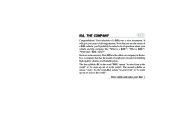 2008 Kia Rondo Owners Manual, 2008 - 1 of 341
2008 Kia Rondo Owners Manual, 2008 - 1 of 341 2008 Kia Rondo Owners Manual, 2008 - 2 of 341
2008 Kia Rondo Owners Manual, 2008 - 2 of 341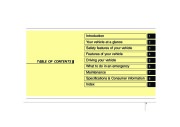 2008 Kia Rondo Owners Manual, 2008 - 3 of 341
2008 Kia Rondo Owners Manual, 2008 - 3 of 341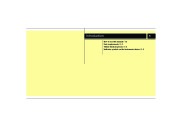 2008 Kia Rondo Owners Manual, 2008 - 4 of 341
2008 Kia Rondo Owners Manual, 2008 - 4 of 341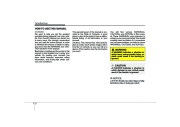 2008 Kia Rondo Owners Manual, 2008 - 5 of 341
2008 Kia Rondo Owners Manual, 2008 - 5 of 341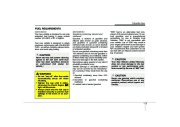 2008 Kia Rondo Owners Manual, 2008 - 6 of 341
2008 Kia Rondo Owners Manual, 2008 - 6 of 341 2008 Kia Rondo Owners Manual, 2008 - 7 of 341
2008 Kia Rondo Owners Manual, 2008 - 7 of 341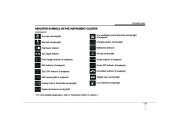 2008 Kia Rondo Owners Manual, 2008 - 8 of 341
2008 Kia Rondo Owners Manual, 2008 - 8 of 341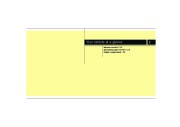 2008 Kia Rondo Owners Manual, 2008 - 9 of 341
2008 Kia Rondo Owners Manual, 2008 - 9 of 341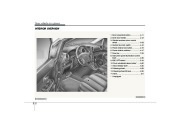 2008 Kia Rondo Owners Manual, 2008 - 10 of 341
2008 Kia Rondo Owners Manual, 2008 - 10 of 341